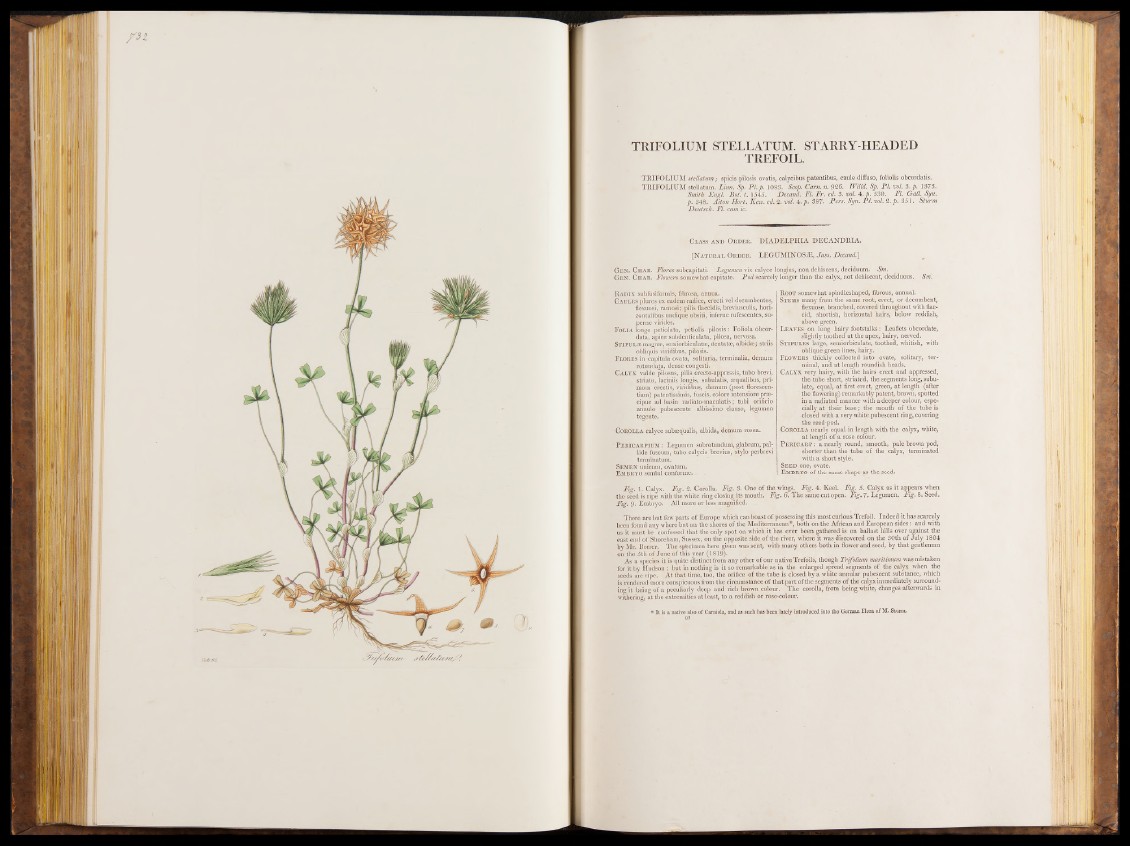
TRIFOLIUM STELLATUM. STARRY-HEADED
TREFOIL.
T R IFO L IUM stellatum ; spicis pilosis ovatis, calycibus patentibus, caule diffuso, foliolis obcordatis.
T R IFO L IUM stellatum. Linn. Sp. P L p. 1083. Scop. Cam. n. 926. Willd. Sp. P L vol. 3. p. 1373.
Smith Engl. Bot. t. 1545. Decand. Fl. F r . ed. 3. vol. 4s. p. 530. FL Gall. Syn.
p . 348. Alton Hort. K m . ed. % vol. 4. p. 387. P ers. Syn. P L vol. % p. 351. Sturm
Deutsch. Fl. cum ic.
Glass a n d Order. D IA D E L PH IA D ECANDRIA.
[N atural Order. L EGUMINOSiE, Juss. Decand.]
Gen. Char. Flores subcapitati. Legumen vix calyce longius, non dehiscens, deciduum. Sm.
Gen . Char. Flowers somewhatcapitate. Pod scarcely longer than the calyx, not dehiscent, deciduous. Sm.
Radix subfusiformis, fibrosa, annua.
CaüLES plures ex eadem radice, erecti vel decumbentes,
flexuosi, ramosi; pilis flaccidis, breviusculis, hori-
zontalibus undique obsiti, inferne rufescentes, su-
. , perne virides.
Folia longe petiolata, petiolis pilosis : Foliola obcor-
data, apice subdenticulata, pilosa, nervosa.
STIPULEE magnas, semiorbiculatæ, dentatæ, albidoe; striis
'à -,-, obliquis viridibus, pilosis.
Flores in capitula ovata, solitaria, terminalia, demum
rotundata, dense congesti.
Calyx valde pilosus, pilis erecto-appressis, tubo brevi,
• - strialo, laciniis ïongis, subulatis, æqualibus, pri-
mum erectis, viridibus, demum (post florescen-
tiam) patentissimis, fuscis, colore intensiore præ-
' cipue ad basin radiato-maculatis ; tubi orificio
annulo pubescente albissimo clauso, legumen
s tegente.
CoRolla calyce subæqualis, albida, demum rosea.
■ Pericarpium : Legumen subrotundum, glabrum, pal-
lide fuscum, tubo calycis brevius, stylo perbrevi
terminatum.
Semen unicum, ovatum.
Embryo semini conforme. .. .
Root somewhat spindleshaped, fibrous, annual.
Stems many from the same root, erect, or decumbent,
flexuose, branched, covered throughout with flaccid,
shortish, horizontal hairs, below reddish,
above green.
Leaves on long hairy footstalks: Leaflets obcordate,
slightly toothed at the apex, hairy, nerved.
Stipules large, semiorbiculate, toothed, whitish, with
oblique green lines, hairy.
Flowers thickly collected into ovate, solitary, terminal,
and at length roundish heads.
Calyx very hairy, with the hairs erect and Oppressed,
the tube short, striated, the segments long, subulate,
equal, at first erect, green, at length (after
the flowering) remarkably patent, brown, spotted
in a radiated manner with a deeper colour, especially
at their base; the mouth of the tube is
•closed with a very white pubescent ring, covering
the seed-pod.
Corolla nearly equal in length with the calyx, white,
at length of a rose colour.
Pericarp : a nearly round, smooth, pale brown pod,
shorter than the tube of the calyx, terminated
with a short style.
Seed one, ovate.
Embryo of the same shape as the seed.
Fig. 1. Calyx. Fig. 2. Corolla. Fig. 3. One of the wings. Fig. 4. Keel. Fig. 5. Calyx as it appears when
the seed is ripe with the white ring closing its mouth. Fig. 6. The same cut open. Fig. 7. Legumen. Fig. 8. Seed.
Fig. 9. Embryo. All more or less magnified.
There are but few parts of Europe which can boast of possessing this most curious Trefoil. Indeed it has scarcely
been found any where but on the shores o f the Mediterranean*, both on the African and European sides: and with
us it must be confessed that the only spot on which.it has ever been gathered is on ballast hills over against the
east end of Shoreham, Sussex, on the opposite side of the river, where it was discovered on the 30th of July 1804
by Mr. Borrer. The specimen here given was sent, with many others both in flower and seed, by that gentleman
on the 5th o f June of this year (1819).
As a species it is quite distinct from any other of our native Trefoils, though Trifolium maritimum was mistaken
for it by Hudson : but in nothing is it so remarkable as in the enlarged spread segments of the calyx when the
seeds are ripe. At that time, too, the orifice of the tube is closed by a white annular pubescent substance, which
is rendered more conspicuous from the circumstance of that part of the segments of the calyx immediately surrounding
it being of a peculiarly deep and rich brown colour. The corolla, from being white, changes afterwards in
withering, at the extremities a t least, to a reddish or rose-colour.
* It is a native also of Camiola, and as such has been lately introduced into the German Flora of M. Sturm.
99